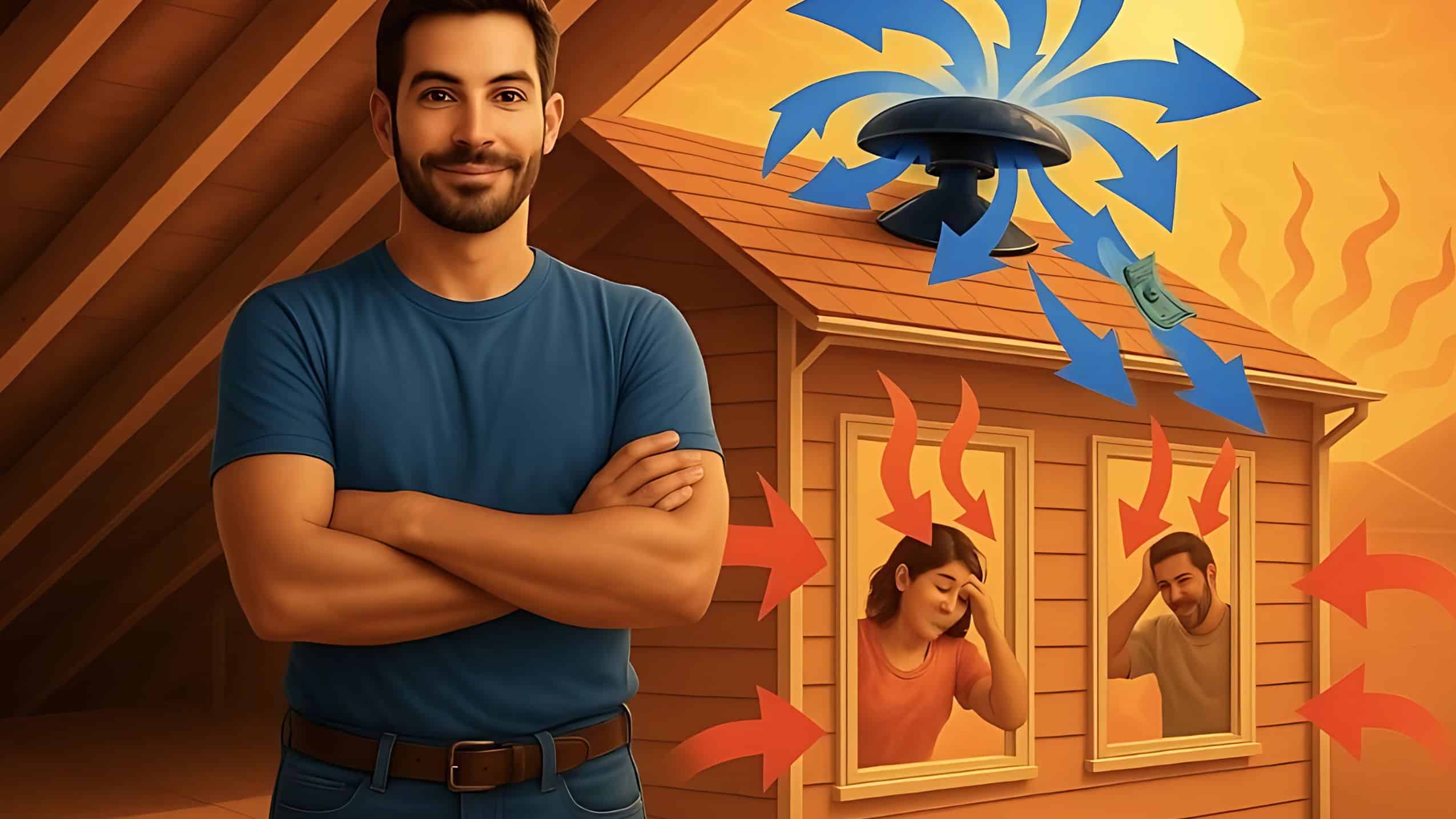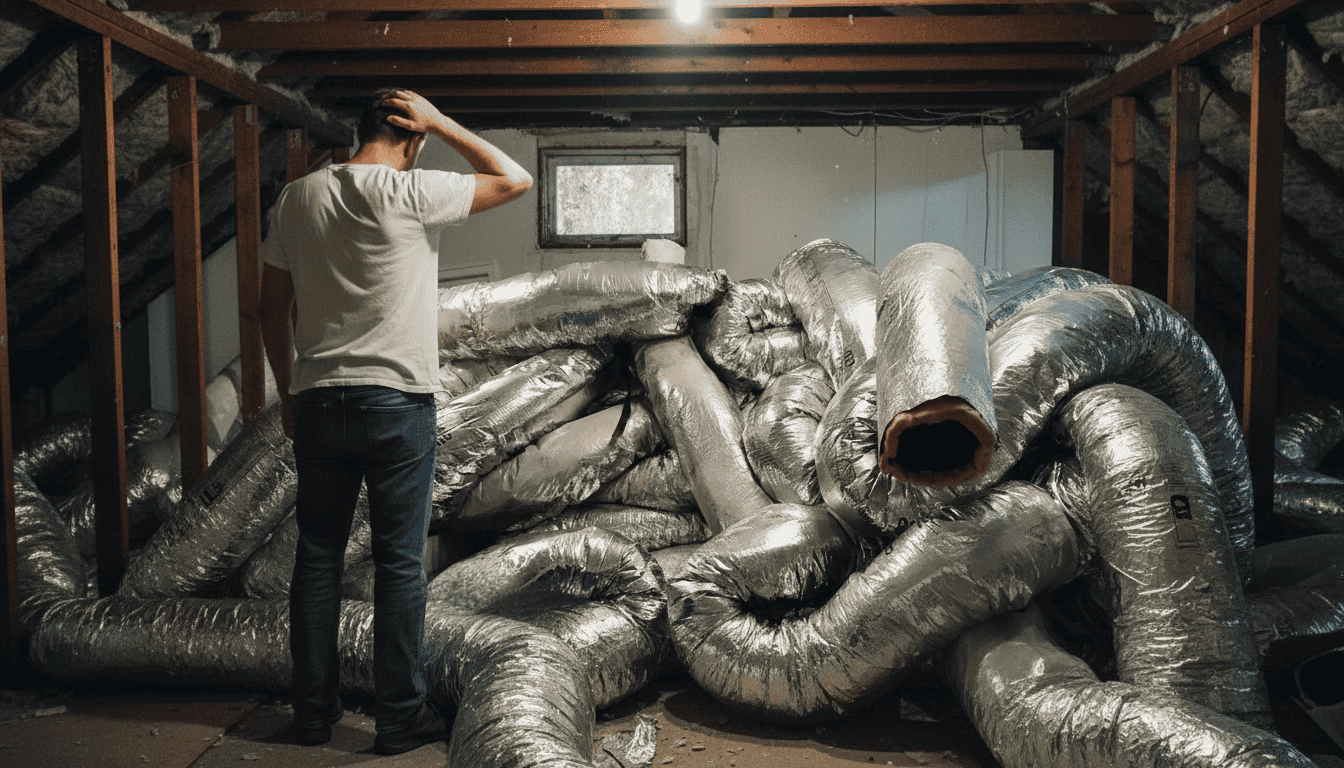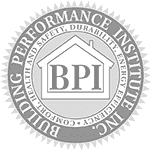When it comes to home energy efficiency, few topics spark as much debate among homeowners and contractors as attic ventilation. As someone deeply invested in helping clients lower their energy bills and improve indoor air quality, I’ve seen firsthand how misinformation, often perpetuated by industry professionals, leads to costly, ineffective, and sometimes even damaging decisions. One of the most persistent myths? That powered attic ventilators (mechanical turbine fans) are a cure-all for hot attics and high cooling bills. In fact, the majority of these cases prove just the opposite.
Let’s set the record straight with research facts, technical insights, and what real real life case studies say about these devices.
What Are Powered Attic Ventilators?
Powered attic ventilators (PAVs) are electric or solar-powered fans installed on the roof or gable, designed to force hot air out of the attic. The theory is simple: by removing hot air, you reduce attic temperatures, which should, in turn, lower your cooling costs and make your home more comfortable.
It sounds logical, but the reality is far more complicated.
The “Cool Attic” Illusion
Many contractors and roofers claim that PAVs are essential because they make the attic feel cooler. This is technically true: a running fan does reduce attic temperature. But here’s the catch: a cooler attic doesn’t always mean a more efficient or comfortable home. In fact, the way these fans operate can actually increase your cooling costs and create new problems.
The Hidden Problems with Powered Attic Fans
Increased Energy Costs
Electricity Use: The energy required to run a powered fan often offsets any savings from reduced attic heat. Studies have shown that the energy consumption of the fan can outweigh the small reduction in cooling energy use, resulting in little or no net savings.
ROI Reality: The return on investment for powered attic fans is poor. One study found that while attic temperatures dropped, the reduction in cooling costs was less than the electricity used by the fan itself.
Home Depressurization and Air Leakage
Negative Pressure: PAVs create negative pressure in the attic. If there aren’t enough soffit or lower intake vents, the fan will draw air from wherever it can, including conditioned air from your living space.
Costly Air Loss: This means your expensive, air-conditioned air gets sucked into the attic and expelled outside, forcing your AC to work even harder and driving up your utility bills.
Moisture and Mold Risks
Unintended Consequences: When attic fans pull moist outdoor air (especially in humid climates like New Orleans) or conditioned air from the house into the attic, they can increase the risk of condensation and mold growth in both the attic and the living space.
Indoor Air Quality: Poorly designed or installed attic fans can actually worsen indoor air quality by introducing allergens, dust, and moisture into the home.
Potential for Carbon Monoxide Backdrafting
Safety Hazard: If your home has gas appliances, a strong attic fan can create enough negative pressure to backdraft carbon monoxide into the living space—a serious health risk.
Maintenance, Lifespan, and Upfront Costs
Limited Durability: Mechanical fans have moving parts that wear out, require regular maintenance, and often have a shorter lifespan than passive systems.
Installation Issues: Poor installation can lead to roof leaks and additional repair costs.
The Comfort Fallacy: The attic feels cooler, so the system must be working, right? Unfortunately, this ignores the bigger picture of whole-home performance.
Industry Momentum: Many contractors recommend what they’ve always heard or been taught, rather than what research and building science now show.
Visual Results: It’s easy to sell a solution that produces an immediate, tangible effect (cooler attic air), even if it’s not the right solution for the homeowner.
What Does the Research Say?
Study/Source Key Findings
Florida Solar Energy Center (FSEC): Powered attic fans reduced attic temps by 22°F but only cut AC use by 6%. The fan’s own energy use negated any savings.
Energy Vanguard: Fans don’t address radiant heat transfer from the roof to the attic floor; much of the heat still enters the home.
EnergyTexas: The energy needed to run the fan typically cancels out any savings from improved ventilation.
Green Building Advisor: Powered fans can cause combustion safety problems and increase cooling bills if not installed with sufficient intake vents.
Passive Ventilation: The Smarter, More Efficient Alternative
Ridge Vents and Soffit Vents
Passive, No Power Needed: Ridge vents, when paired with adequate soffit vents, use natural convection to exhaust hot air—no electricity required, no moving parts to fail.
Consistent Airflow: These systems provide continuous, balanced ventilation, reducing heat and moisture buildup without risking depressurization or energy waste.
Low Maintenance, Long Lifespan: With no motors or mechanical parts, passive systems are quieter, last longer, and require less maintenance.
ROI and Energy Savings
Lower Bills: Proper passive ventilation can reduce attic heat gain, lower cooling loads, and extend the lifespan of your roof and HVAC system, providing a much better return on investment over time.
Better Indoor Air Quality: By preventing moisture and mold, passive systems help keep your home healthier.
When Might a Powered Fan Make Sense?
I have personally heard few professionals feel that a PAV may make sense, but only if it pertains to a severely under-ventilated attic. In rare cases where passive ventilation isn’t feasible due to roof design some believe a powered fan – arguably solar – might be considered, but firstly if there is ample in-take ventilation and careful attention to air sealing. However, even under this theory, the reality of the matter is that although it feels like a good argument, just as the power-ventilated attic does in fact feel cooler, we still come back full circle to the same original unescapable facts listed above. Just because the appropriate amount of passive ventilation cannot be achieved, doesn’t mean reality gives a pass to the physics behind the reasons PAV’s do more damage than good.
Solar Options: Solar is green. Solar is the future. Solar saves money! Yes, very true, but only relative to traditional electric PAVs. But solar me this, even if solar attic fans can reduce operational costs, did the awe-inspiring beauty of solar somehow, again, give a pass to the physics behind the reasons PAV’s do more damage than good? And give a case of the déjà vu’s
How Strong Is Too Strong?
Standard Electric Attic Fans: High Airflow, Higher Energy Use
Most standard electric attic fans are designed to deliver robust airflow—typically ranging from 1,200 to 1,600 CFM. Some large or heavy-duty models can even exceed 1,400 CFM, making them a strong choice for bigger or more complex attic spaces. This high airflow helps quickly exhaust hot air from the attic, but it’s important to remember that running these fans draws power from your home’s electrical system. While they offer reliable, consistent performance, energy usage can add up, especially during the hottest months.
Solar-Powered Attic Fans: Lower CFM, Sun-Driven Operation
Solar-powered attic fans, on the other hand, are rated for much lower CFM on average. Typical small to mid-sized solar fans provide between 250 and 850 CFM. Larger or more powerful solar models—like those equipped with 40-watt or higher panels—can reach peak outputs up to around 1,100 to 1,500 CFM under strong sunlight. However, the most commonly available units are typically rated in the 400–850 CFM range. It’s also important to note that real-world output can be lower, depending on panel quality, installation angle, and available sunlight, often falling somewhere between 250 and 750 CFM.
What About ENERGY STAR And Attic Fans?
Nearly 90% of U.S. households recognize the ENERGY STAR logo when shown the label. And what do we visualize when we see the ENERGY STAR Logo? Perhaps, most of us recognize it as the pillar of promoting energy efficiency across our beloved United States. From lighting to dishwashers, down to 10” smart power strips, and as large as a vending machine, ENERGY STAR tests and proudly labels those items that demonstrate considerable energy savings. However, one thing ENERGY STAR does not certify and label is powered attic fans.
But they obviously approve solar PAVs? They do not. Energy Star Program research and case studies demonstrate they do more harm than good. Regardless if the PAV is actively powered or passively solar powered, the depressurization phenomenon remains the same.
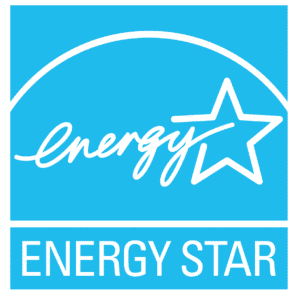
The Bottom Line: Don’t Fall for the “Cool Attic” Trap
If you’re a homeowner or a contractor, don’t be swayed by the immediate comfort of a cooler attic or the confident sales pitch of a “professional” who hasn’t kept up with building science. The evidence is clear: powered attic ventilators often do more harm than good, increasing energy costs, risking indoor air quality, and offering poor ROI compared to passive solutions. Instead, consider focusing on other upgrades such as Proper air sealing and insulation. Diagnosing and repairing your central system’s ductwork air-leakage, thereby eliminating the depressurized suction of outside humid air into your home. Balanced passive ventilation (ridge + soffit vents). And, focusing on whole-home performance, not specifically the attic temperature.
By taking a technical, research-backed approach, you’ll save money, improve comfort, and protect your home for years to come.
Let’s Pull the Plug on the PAV, Shall We?
By now, you’ve probably realized that powered attic ventilators (PAVs) are kind of like that one guy in a group project who looks busy but is actually making things worse for everyone. Sure, they seem helpful, whirring away up there on the roof like they’ve got heroic plans to save your attic from the sweltering Southern heat. But in reality, they’re often up there sucking your nice, cool, expensive indoor air out of your home like a reverse Santa Claus robbing comfort instead of delivering it.
The state of Georgia saw through their act back in 2011 and made the bold move to ban them from new construction – unless they’re powered by solar, which we’ll admit is at least a cleaner kind of questionable decision. And look, if a whole state is saying, “Let’s not do this anymore,” it might be time to take a closer look at whether these things really belong in your home performance plan.
At Diversified Energy, we’ve been telling our clients along the Gulf South for years – turn the PAVs off. In fact, when we’re insulating attics, one of the first things we check for is those roof-mounted energy-efficiency imposters. Why? Because the numbers (and the physics) just don’t lie: PAVs can increase air infiltration, drive up utility bills, and make your HVAC system work harder. Plus, they tend to ignore the real issue: radiant heat from the roof, which you can’t fix with a fan, no matter how many CFMs you’ve got.
Here’s the deal: we’re not here to sell you a bunch of stuff you don’t need just to keep our trucks busy. We approach every home with the big picture in mind, building holistic, customized solutions that actually solve problems—comfort, energy efficiency, indoor air quality—not just slap a band-aid (or a fan) on symptoms. Sometimes that means adding insulation, sealing air leaks, or upgrading ventilation. But sometimes—and we say this with all the love in the world for good-intentioned DIYers—it means removing something that’s doing more harm than good.
We’re not shy about saying, “Hey, you know what might actually help? Taking that thing out.” And truth be told, that’s often a lot less expensive than installing new equipment that may or may not help. We call it the Subtractive Fix, and it’s just one example of how we put your comfort, health, and energy savings ahead of simply adding more widgets to your rooftop.
If you or someone you know is suffering from a “fix” or collection of fixes that aren’t doing squat for energy bills and comfort, please give us a call at 504-273-7779.
Study/Source Key Findings
Florida Solar Energy Center (FSEC): Powered attic fans reduced attic temps by 22°F but only cut AC use by 6%. The fan’s own energy use negated any savings – Click Here
Energy Vanguard: Fans don’t address radiant heat transfer from the roof to the attic floor; much of the heat still enters the home – Click Here
Building America Solution Center: The cooling effect on the living space below the attic is usually much less than might be expected – Click Here
Green Building Advisor: Powered fans can cause combustion safety problems and increase cooling bills if not installed with sufficient intake vents – Click Here
EnergyTexas: The energy needed to run the fan typically cancels out any savings from improved ventilation – Click Here
Additional references available upon request. All technical claims and recommendations are based on third-party building science research and non-biased industry sources.
